Building a Culture of Accountability Through Data Governance
Accountability has become a cornerstone in managing organizational data. As businesses rely more on data-driven decisions, ensuring that every individual takes responsibility for their role in data handling is essential. Data governance provides the framework to achieve this by defining clear processes and responsibilities. It fosters trust, enhances compliance, and improves operational efficiency. Building a culture of accountability requires more than policies—it demands a shift in mindset. By embedding the ingredients of data governance into daily practices, you can create an environment where transparency and integrity thrive.
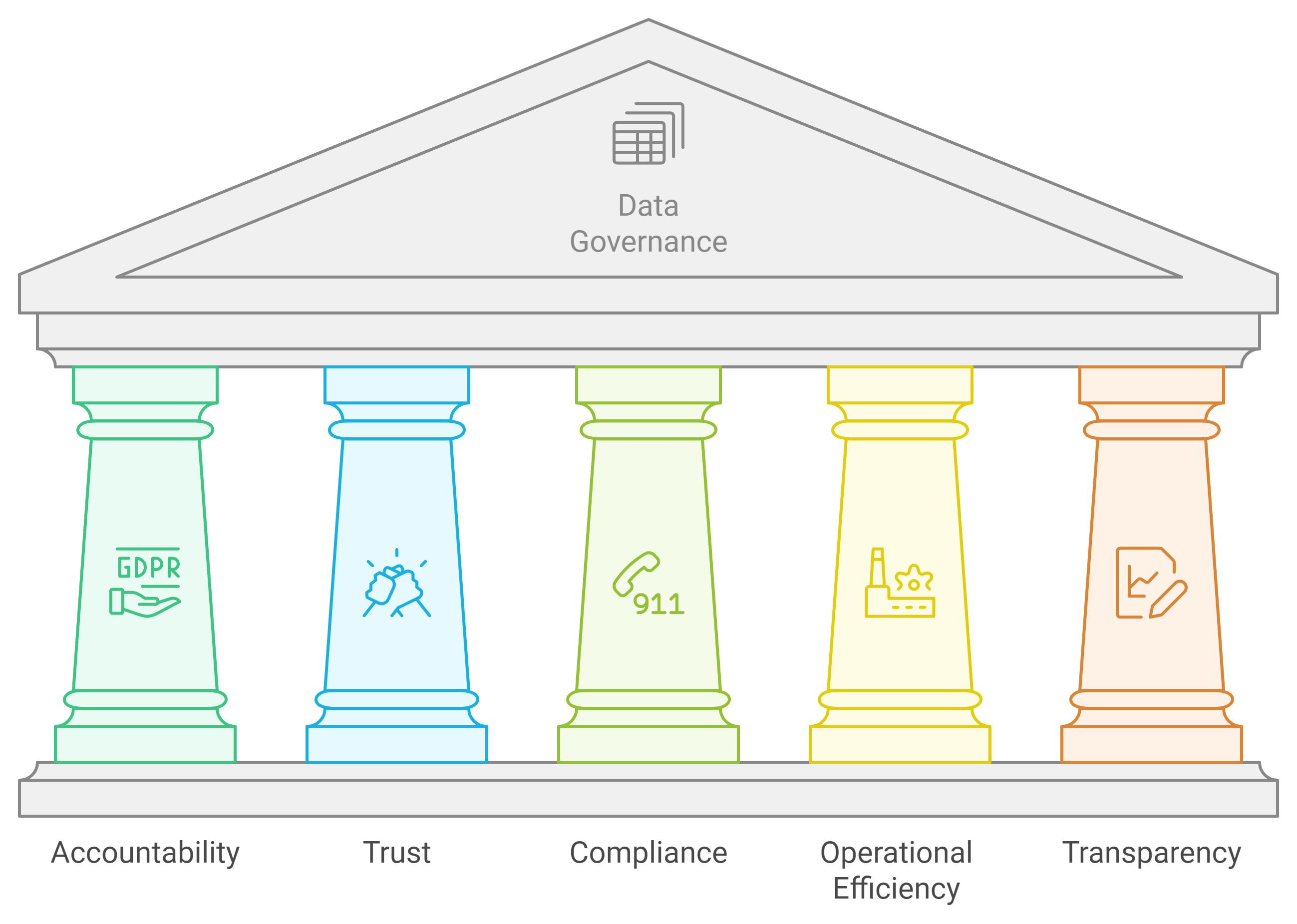
Key Takeaways
Establish clear roles and responsibilities to enhance accountability in data management, ensuring everyone knows their specific duties.
Foster cross-departmental collaboration to break down silos, allowing for a unified approach to data governance and improved operational efficiency.
Implement regular training programs to boost data literacy across the organization, empowering employees to take ownership of their data-related responsibilities.
Utilize tools like data catalogs and lineage tracking systems to enhance transparency, making it easier for teams to access and understand data assets.
Conduct regular audits to ensure compliance with governance policies, identify gaps, and drive continuous improvement in data practices.
Encourage open communication about data practices, creating a culture where feedback is valued and contributes to better governance outcomes.
Recognize and reward accountability within teams to reinforce positive behaviors and motivate employees to uphold data governance standards.
Defining Data Governance and Accountability
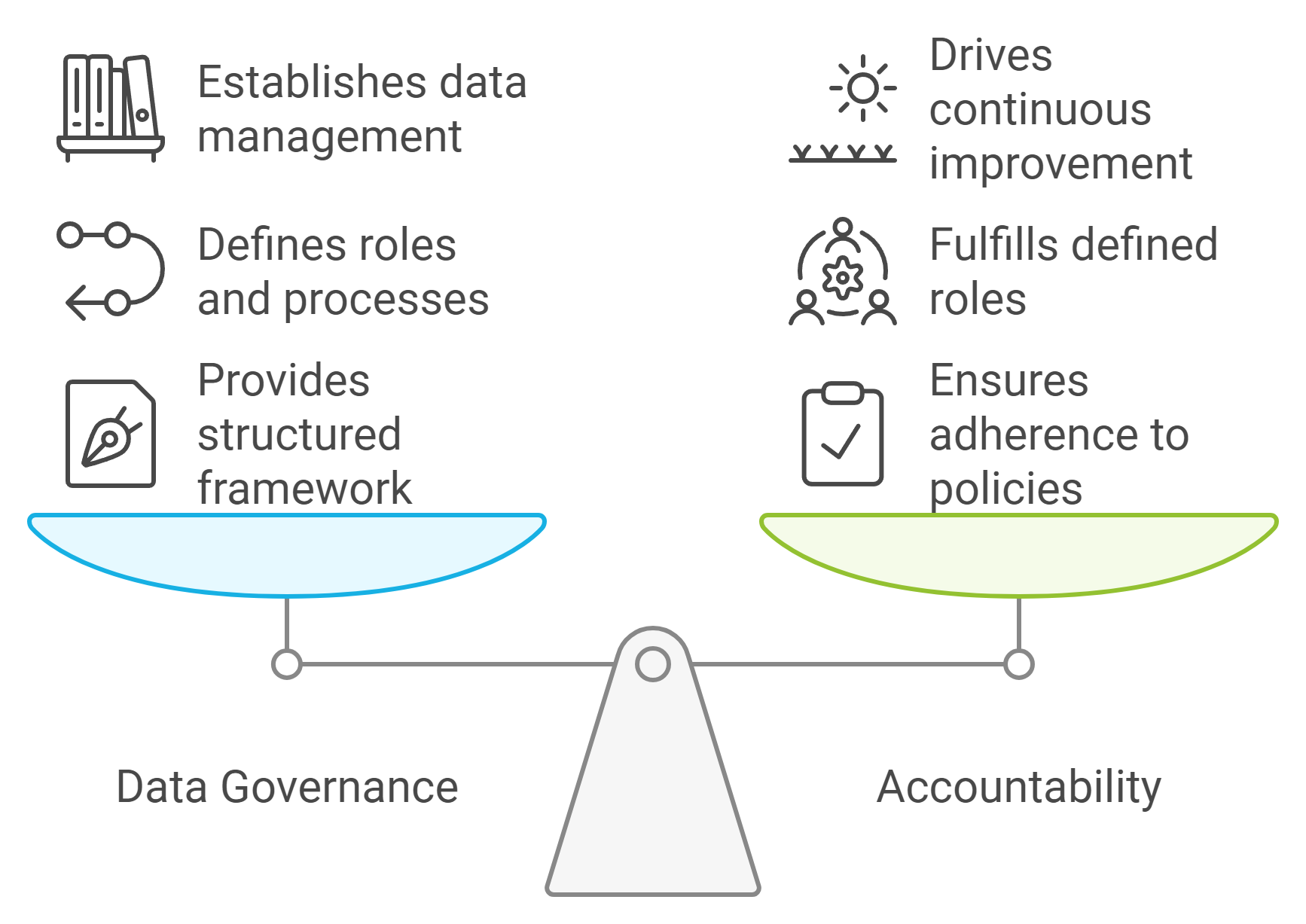
What is Data Governance?
Data governance establishes a structured framework for managing data as a valuable asset. It defines policies, assigns responsibilities, and implements processes to ensure data quality, security, and compliance. By setting clear guidelines, data governance helps you maintain consistency and reliability in your data. This framework ensures that data remains accessible, accurate, and protected from unauthorized access. Organizations use data governance to align their data management practices with business goals and regulatory requirements.
Effective data governance also introduces checks and balances. It bridges gaps between teams that create, manage, and use data. For example, it ensures that those collecting data collaborate with those analyzing it, fostering a unified approach to data handling. This coordination enhances operational efficiency and reduces risks associated with data misuse or mismanagement.
What Does Accountability Mean in the Context of Data?
Accountability in data management means taking responsibility for how data is handled, stored, and used. It ensures that every individual involved in data processes understands their role and remains answerable for their actions. Accountability fosters trust, transparency, and integrity within an organization. When you know who is responsible for specific data tasks, it becomes easier to identify and address issues.
For instance, assigning clear ownership of data ensures that someone is always responsible for maintaining its quality and accuracy. This clarity prevents situations where no one takes responsibility for errors or inconsistencies. Accountability also supports compliance with regulations by ensuring that individuals follow established policies and procedures.
In a culture of accountability, employees view data stewardship as a shared responsibility. They recognize the importance of ethical data practices and work collectively to uphold them. This mindset strengthens the organization's ability to make informed decisions and achieve strategic goals.
The Interconnection Between Data Governance and Accountability
Data governance and accountability are deeply interconnected. Governance provides the structure, while accountability ensures that individuals adhere to it. Together, they create a culture where data is managed responsibly and effectively. Without accountability, governance policies may exist but lack enforcement. Similarly, without governance, accountability becomes fragmented and inconsistent.
For example, data governance frameworks define roles, responsibilities, and processes. Accountability ensures that these roles are fulfilled and processes are followed. When you integrate accountability into governance, you create a system where everyone understands their duties and takes ownership of their actions. This integration enhances data quality, security, and compliance.
Moreover, accountability drives continuous improvement in governance practices. Regular audits and feedback loops help identify gaps and refine policies. This iterative process ensures that governance frameworks remain relevant and effective in a rapidly evolving data landscape. By fostering a culture of accountability, you empower your organization to thrive in the data-driven era.
Key Components of Data Governance for a Culture of Accountability
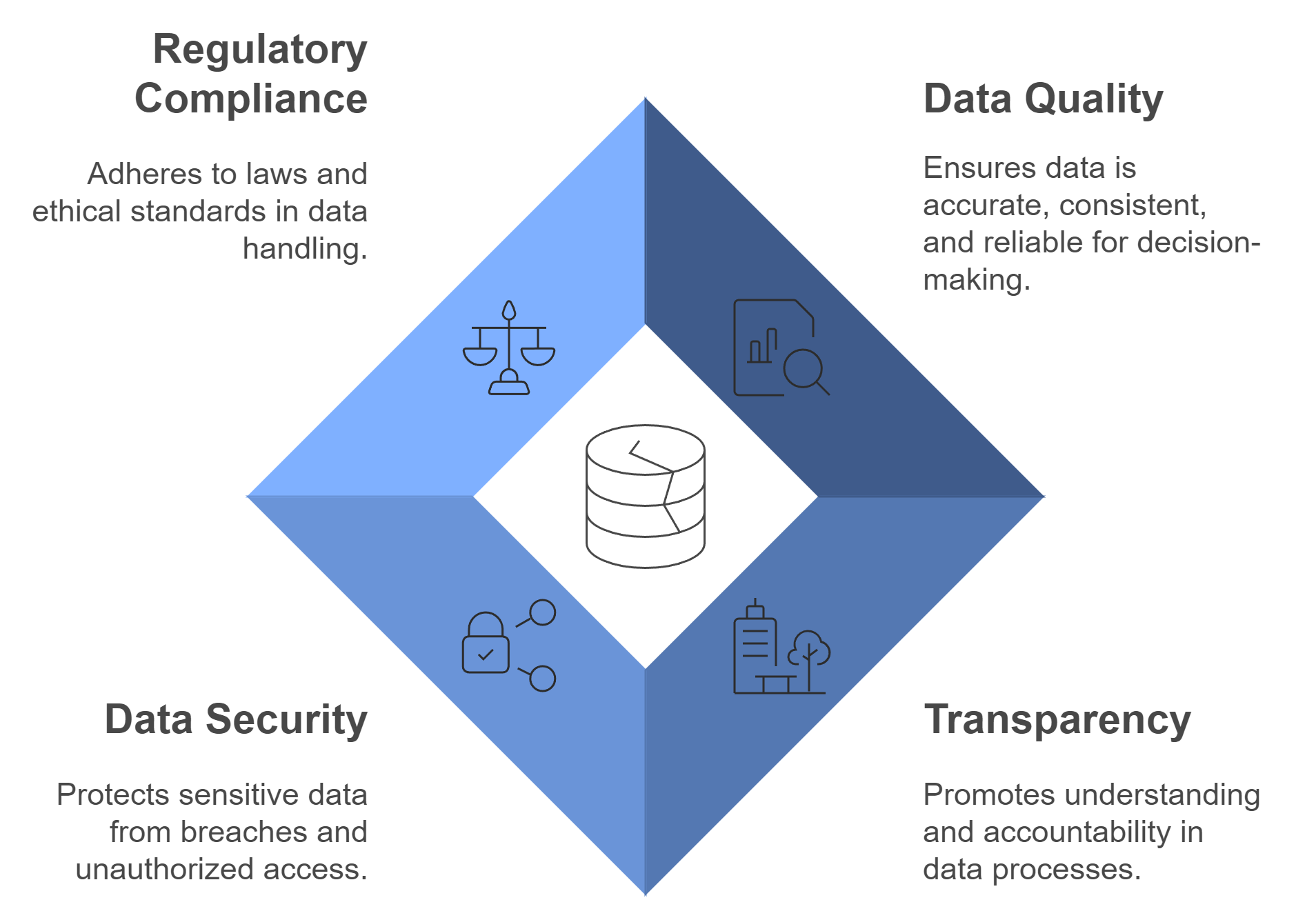
Data Quality and Accuracy
Data quality forms the backbone of effective governance. When your data is accurate, consistent, and reliable, it becomes a powerful tool for decision-making. Poor data quality, on the other hand, leads to errors, inefficiencies, and mistrust. To ensure high-quality data, you must establish processes that validate and cleanse data regularly. This includes identifying duplicates, correcting inaccuracies, and standardizing formats.
Organizations with strong data governance practices often experience fewer data-related errors. For example, aligning governance with existing processes can reduce operational costs by up to 20%. By prioritizing data quality, you not only improve efficiency but also build trust in your data assets. This trust is essential for fostering a culture of accountability, where everyone takes responsibility for maintaining data integrity.
Transparency in Data Management
Transparency ensures that everyone in your organization understands how data is collected, stored, and used. Clear documentation of data processes and policies eliminates confusion and promotes accountability. When you make data management practices visible, it becomes easier to identify gaps and address them proactively.
A transparent approach also involves assigning clear ownership of data. When roles and responsibilities are well-defined, individuals know what is expected of them. This clarity reduces the risk of mismanagement and ensures that data is handled responsibly. Transparency not only supports compliance with regulations but also strengthens your organization's ability to make informed decisions.
To enhance transparency, consider implementing tools like data catalogs. These tools provide a centralized view of your data assets, making it easier for teams to access and understand the information they need. By fostering openness in data management, you create an environment where accountability thrives.
Data Security and Privacy
Protecting sensitive data is a critical component of governance. Data breaches and unauthorized access can have severe consequences, including financial losses and reputational damage. To safeguard your data, you must implement robust security measures such as encryption, access controls, and regular audits.
Privacy regulations like GDPR and CCPA emphasize the importance of securing personal data. Compliance with these regulations not only protects your organization from legal penalties but also demonstrates your commitment to ethical data practices. By prioritizing security and privacy, you reinforce a culture of accountability where individuals understand the importance of protecting sensitive information.
Organizations with robust data governance frameworks often excel in managing risks associated with data handling. They establish clear accountability for security tasks, ensuring that every team member plays a role in safeguarding data. This collective effort creates a secure and trustworthy data environment, enabling your organization to operate with confidence.
Regulatory Compliance and Ethical Standards
Regulatory compliance and ethical standards form the backbone of responsible data governance. Adhering to these principles ensures that your organization operates within legal boundaries while maintaining trust with stakeholders. By embedding compliance and ethics into your data practices, you create a culture where accountability becomes second nature.
To achieve regulatory compliance, you must stay informed about the laws and regulations governing data in your industry. Frameworks like GDPR, CCPA, and HIPAA outline specific requirements for data handling, storage, and sharing. Meeting these standards protects your organization from legal penalties and enhances your reputation as a trustworthy entity. For example, organizations with robust compliance practices often experience fewer data breaches and regulatory fines, which directly impacts their operational efficiency and financial stability.
Ethical standards go beyond legal requirements. They guide how you use data responsibly and transparently. Ethical data practices involve respecting user privacy, avoiding misuse of information, and ensuring fairness in data-driven decisions. When you prioritize ethics, you build stronger relationships with customers, employees, and partners. This trust fosters a collaborative environment where everyone feels confident in the organization's data practices.
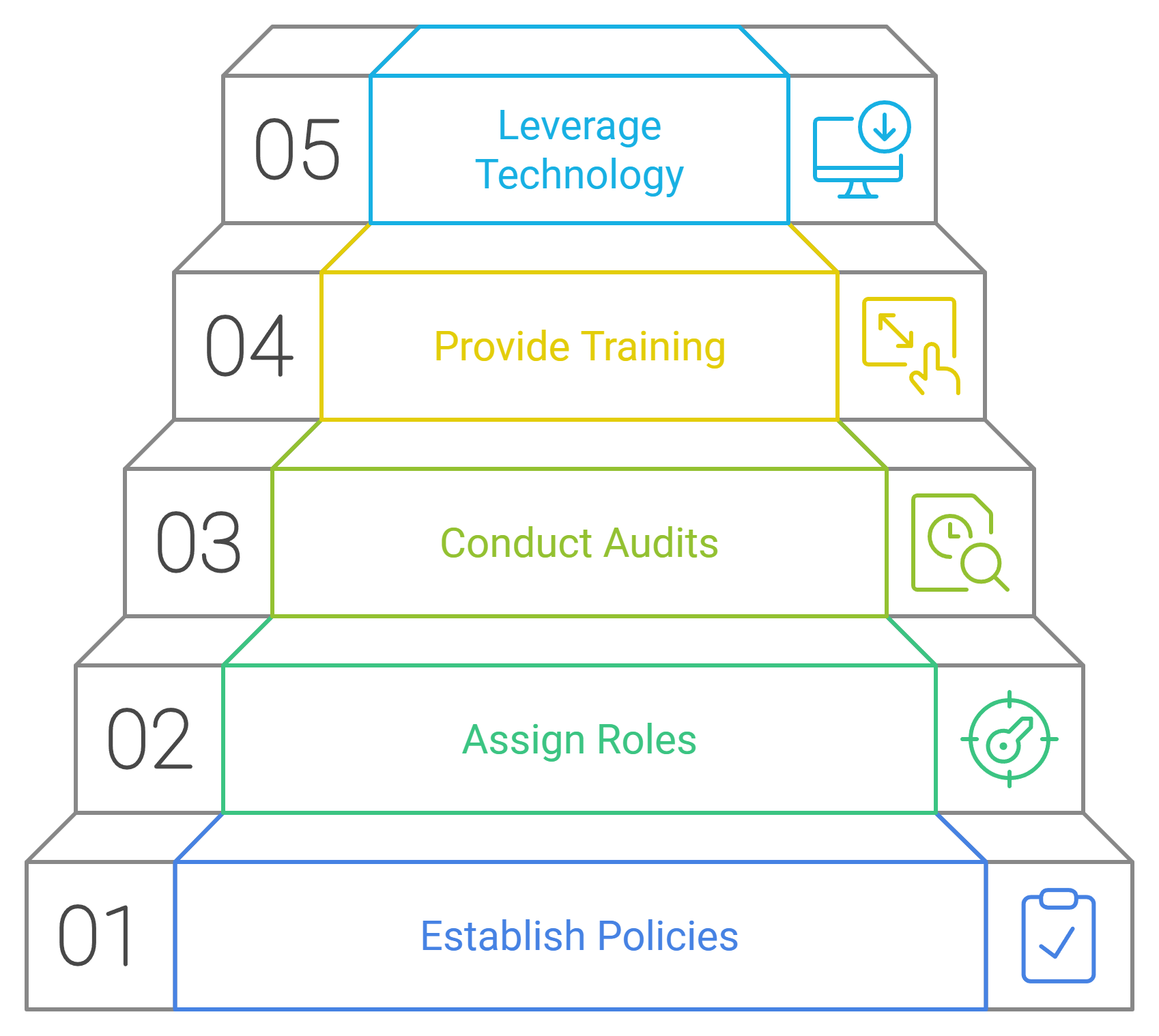
Here are actionable steps to integrate regulatory compliance and ethical standards into your data governance framework:
Establish Clear Policies
Define policies that align with relevant regulations and ethical principles. Document these policies and make them accessible to all employees. Clear guidelines reduce ambiguity and ensure consistent adherence across the organization.Assign Accountability Roles
Designate individuals or teams responsible for monitoring compliance and ethical practices. Accountability ensures that someone is always overseeing critical tasks, such as data audits and risk assessments.Implement Regular Audits
Conduct periodic audits to evaluate your compliance with regulations and adherence to ethical standards. Audits help identify gaps and provide opportunities for improvement. Organizations with regular audits often maintain higher data quality and security.Provide Training and Awareness Programs
Educate employees about the importance of compliance and ethics in data governance. Training programs ensure that everyone understands their responsibilities and the potential consequences of non-compliance.Leverage Technology for Compliance
Use tools like monitoring systems and automated workflows to streamline compliance efforts. For instance, automated alerts can notify you of potential violations, allowing you to address issues proactively.
"Organizations with structured and accountable data governance frameworks ensure data remains accurate, secure, and responsibly used, supporting compliance and informed decision-making."
By embedding regulatory compliance and ethical standards into your data governance strategy, you not only protect your organization but also reinforce a culture of accountability. This approach ensures that your data practices remain transparent, trustworthy, and aligned with both legal and moral expectations.
Steps to Build a Culture of Accountability
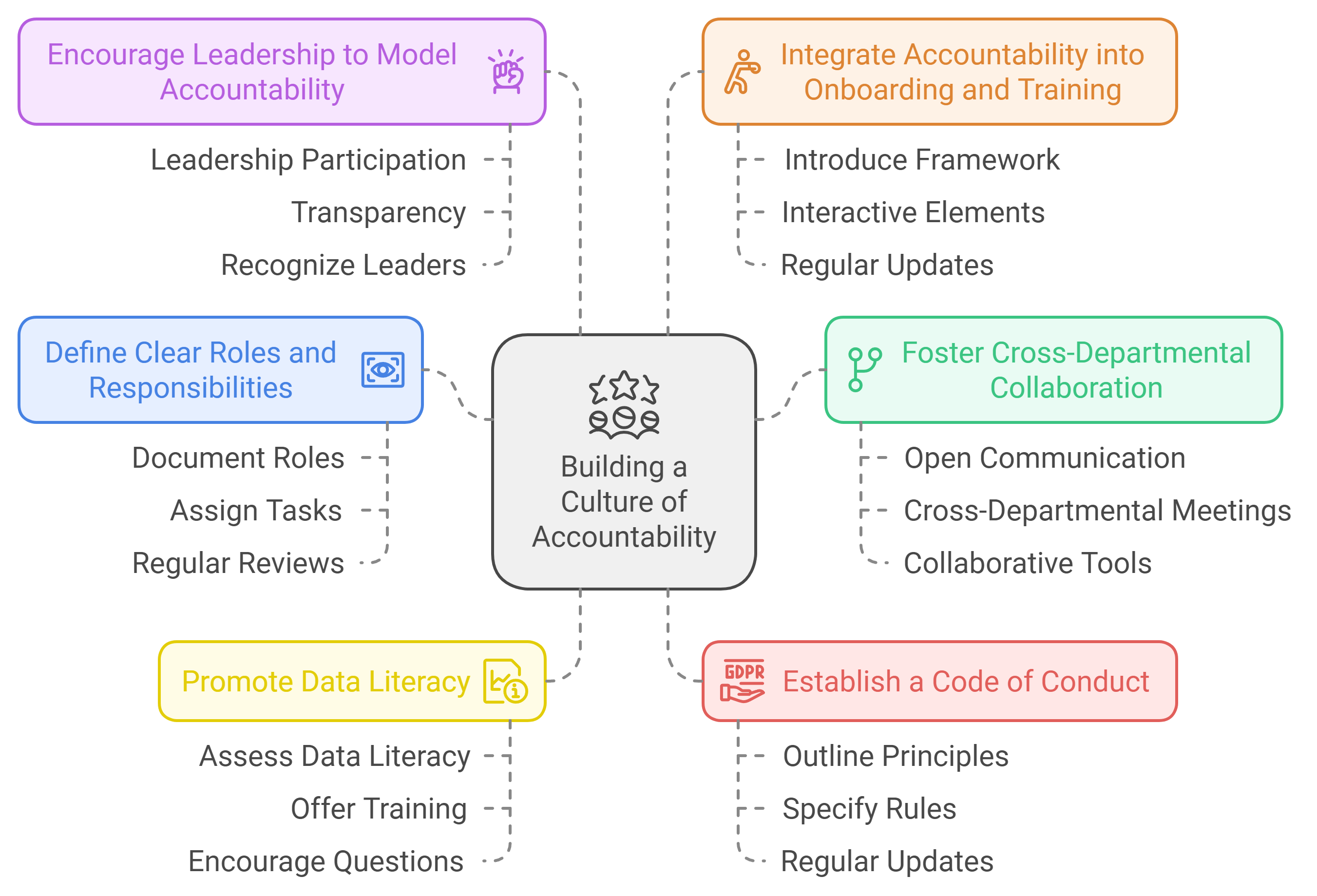
Define Clear Roles and Responsibilities
Establishing clear roles and responsibilities is the foundation of building a culture of accountability. When everyone knows their specific duties, confusion decreases, and ownership increases. Start by identifying key data-related tasks within your organization. Assign these tasks to individuals or teams with the appropriate expertise. For example, designate data stewards to oversee data quality and assign data owners to ensure compliance with governance policies.
Document these roles in a centralized location, such as a data governance framework. This documentation ensures that all employees can access and understand their responsibilities. Regularly review and update these roles to reflect changes in your organization’s structure or goals. By clarifying responsibilities, you create an environment where accountability becomes a natural part of daily operations.
"Accountability thrives when roles are well-defined, and individuals understand their impact on data management."
Foster Cross-Departmental Collaboration
Collaboration between departments is essential for effective data governance. Data often flows across multiple teams, from collection to analysis. Without collaboration, silos form, leading to inconsistencies and inefficiencies. Encourage open communication between business and technology teams to bridge these gaps. For instance, involve both groups in decision-making processes related to data policies and controls.
Introduce regular cross-departmental meetings to discuss data challenges and share insights. Use these meetings to align on goals and ensure that everyone follows the same governance principles. Collaborative tools, such as shared dashboards or project management software, can also facilitate teamwork. By fostering collaboration, you create a unified approach to data management, reinforcing accountability across your organization.
Promote Data Literacy Across the Organization
Data literacy empowers employees to understand and use data effectively. When individuals grasp the importance of data governance, they are more likely to take accountability for their actions. Begin by assessing the current level of data literacy within your organization. Identify gaps and tailor training programs to address them.
Offer workshops, online courses, or interactive sessions to educate employees about data governance principles. Focus on topics like data quality, security, and ethical usage. Make these programs accessible to all departments, not just IT or data teams. Additionally, integrate data literacy into onboarding processes to instill accountability from the start.
Encourage employees to ask questions and seek clarification when needed. Create a culture where learning about data is valued and supported. As data literacy improves, so does the ability of your team to make informed decisions and uphold governance standards.
Establish a Code of Conduct for Data Usage
A well-defined code of conduct for data usage sets clear expectations for how employees should handle and interact with data. This document acts as a guide, ensuring that everyone in your organization understands the ethical and operational standards required for responsible data management. By establishing this code, you create a foundation for accountability and consistency.
To develop an effective code of conduct, start by outlining the key principles of data governance. Include rules for data access, usage, and sharing. Specify acceptable practices for maintaining data quality, protecting sensitive information, and complying with regulations. For example, you might require employees to verify data accuracy before using it in reports or prohibit the sharing of confidential data without proper authorization.
Make the code accessible to all employees. Publish it in a central location, such as your intranet or data governance portal. Regularly review and update the document to reflect changes in regulations or organizational priorities. Encourage employees to refer to the code whenever they face uncertainty about data-related decisions.
"A code of conduct for data usage ensures that employees understand their responsibilities, fostering a culture of trust and accountability."
Training sessions can reinforce the importance of adhering to the code. Use real-world scenarios to illustrate the consequences of non-compliance and the benefits of following best practices. By embedding the code into your organizational culture, you ensure that accountability becomes a shared value.
Encourage Leadership to Model Accountability
Leadership plays a pivotal role in shaping a culture of accountability. When leaders demonstrate responsible data practices, employees are more likely to follow suit. Leaders set the tone for the organization, showing that accountability is not just a policy but a core value.
Encourage leaders to actively participate in data governance initiatives. They should adhere to the same standards outlined in the code of conduct and take ownership of their data-related responsibilities. For instance, leaders can ensure that their teams follow data quality protocols or comply with privacy regulations. Their actions send a powerful message about the importance of accountability.
Transparency is another critical aspect of leadership. Leaders should openly communicate their data decisions and the rationale behind them. This openness builds trust and encourages employees to adopt similar practices. For example, a leader might share how they used data to make a strategic decision, highlighting the steps they took to ensure accuracy and compliance.
Recognize and reward leaders who model accountability. Public acknowledgment of their efforts reinforces the value of responsible data practices. It also motivates others to follow their example. By prioritizing accountability at the leadership level, you create a ripple effect that influences the entire organization.
Integrate Accountability into Onboarding and Training Programs
Onboarding and training programs provide an excellent opportunity to instill accountability from the start. New employees should understand their data-related responsibilities and the importance of adhering to governance policies. Early education ensures that accountability becomes a natural part of their workflow.
During onboarding, introduce employees to your data governance framework. Explain the roles and responsibilities associated with data management. Highlight the importance of data quality, security, and compliance. Use simple language and practical examples to make the concepts relatable. For instance, you could demonstrate how following data validation processes prevents errors in decision-making.
Incorporate interactive elements into your training programs. Workshops, quizzes, and role-playing exercises can make learning more engaging. For example, a workshop on identifying data breaches can help employees understand the importance of security measures. Interactive sessions also provide opportunities for employees to ask questions and clarify doubts.
Regularly update training materials to reflect changes in governance policies or industry regulations. Offer refresher courses to ensure that all employees stay informed. By integrating accountability into your training programs, you equip your workforce with the knowledge and skills needed to uphold governance standards. This proactive approach strengthens your organization's commitment to responsible data management.
Tools and Technologies to Support a Culture of Accountability
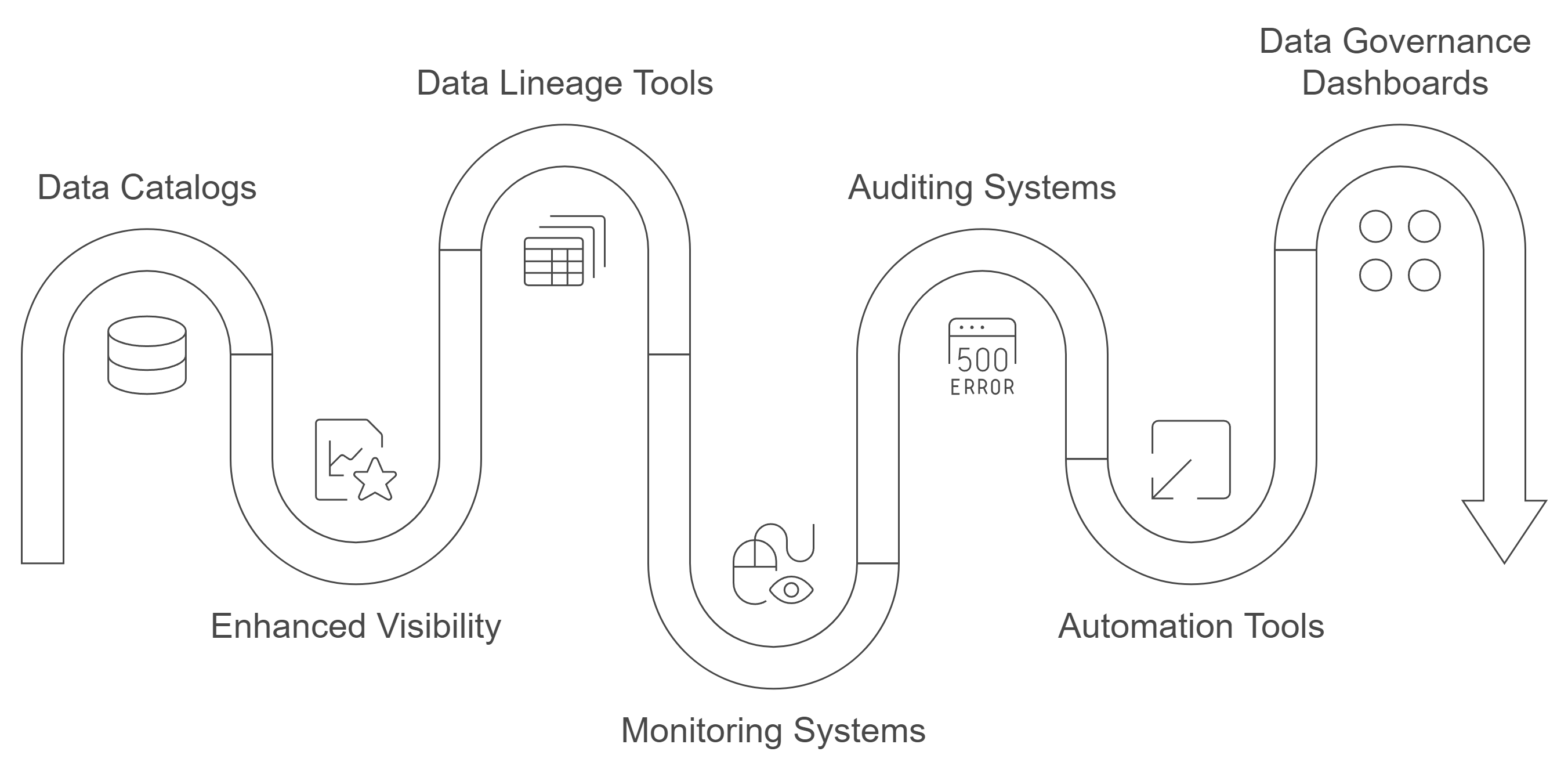
Data Catalogs for Enhanced Visibility
Data catalogs serve as a centralized repository for your organization's data assets. They provide a clear overview of what data exists, where it resides, and how it can be accessed. By using a data catalog, you enhance visibility across teams, ensuring everyone knows the available resources. This transparency fosters accountability by eliminating confusion about data ownership and usage.
A well-implemented data catalog allows you to tag data with relevant metadata. Metadata describes the data's purpose, origin, and structure, making it easier to locate and understand. For example, if your marketing team needs customer demographics, they can quickly find the relevant dataset without relying on IT support. This efficiency reduces bottlenecks and empowers teams to take responsibility for their data needs.
"When employees have access to a clear and organized data catalog, they are more likely to use data responsibly and effectively."
To maximize the benefits of a data catalog, ensure it stays updated. Regularly review and refine the catalog to reflect changes in your data landscape. Encourage teams to contribute to its maintenance by documenting new datasets or updating outdated information. This collaborative approach strengthens accountability and keeps your data ecosystem organized.
Data Lineage Tools for Tracking Data Flow
Data lineage tools help you trace the journey of data from its origin to its final destination. These tools provide a visual map of how data moves through your systems, highlighting every transformation and interaction along the way. Understanding data flow is crucial for accountability, as it reveals who interacts with the data and how it changes over time.
For instance, if an error occurs in a report, data lineage tools allow you to pinpoint the source of the issue. You can identify whether the problem originated during data collection, processing, or analysis. This clarity ensures that the responsible parties can address the error promptly, minimizing its impact on decision-making.
Data lineage also supports compliance efforts. Many regulations require organizations to demonstrate how they handle and process data. By using lineage tools, you can provide detailed records of your data practices, showcasing your commitment to transparency and accountability.
To implement data lineage effectively, choose tools that integrate seamlessly with your existing systems. Look for features like automated tracking and real-time updates to ensure accuracy. Train your teams to interpret lineage maps and use them to improve data processes. By leveraging data lineage tools, you create a culture where accountability becomes a natural part of data management.
Monitoring and Auditing Systems for Compliance
Monitoring and auditing systems play a vital role in maintaining accountability. These tools track data activities, ensuring that all actions align with your governance policies. By monitoring data usage, you can detect unauthorized access, identify potential risks, and enforce compliance with regulations.
Auditing systems provide detailed logs of data interactions. These logs serve as evidence of accountability, showing who accessed data, when, and for what purpose. For example, if a breach occurs, audit logs help you investigate the incident and determine responsibility. This level of oversight reinforces trust in your data practices.
"Organizations that regularly monitor and audit their data activities experience fewer compliance issues and build stronger stakeholder confidence."
To enhance the effectiveness of monitoring and auditing systems, establish clear protocols for their use. Define what activities should be tracked and how often audits should occur. Use automated alerts to notify you of suspicious behavior, allowing you to respond quickly. Regularly review audit findings to identify trends and areas for improvement.
Encourage a proactive approach to compliance by involving all employees in monitoring efforts. Provide training on recognizing potential risks and reporting concerns. When everyone contributes to maintaining accountability, your organization becomes more resilient and trustworthy.
By integrating these tools and technologies into your data governance framework, you create a robust foundation for accountability. Each tool addresses a specific aspect of data management, from visibility to compliance, ensuring that your organization operates with integrity and efficiency.
Automation Tools to Reduce Human Error
Automation tools play a vital role in minimizing human error in data management. These tools streamline repetitive tasks, ensuring consistency and accuracy. By reducing manual intervention, you can eliminate common mistakes like data entry errors or miscalculations. Automation not only saves time but also enhances the reliability of your data processes.
For example, automated data validation tools can check for inconsistencies or inaccuracies in real-time. These tools flag errors immediately, allowing you to address them before they impact decision-making. Similarly, workflow automation ensures that data moves through predefined processes without delays or deviations. This structured approach reduces the risk of oversight and keeps your operations running smoothly.
"A study by Professor Gary Latham highlights that individuals who embrace accountability often outperform their peers. Automation tools support this by enabling employees to focus on strategic tasks rather than routine ones."
To implement automation effectively, start by identifying tasks prone to human error. Look for processes that involve large volumes of data or require frequent updates. Choose tools that integrate seamlessly with your existing systems and offer user-friendly interfaces. Training your team on these tools ensures they understand how to use them effectively, further reducing errors.
Automation also supports compliance efforts. Tools like automated audit logs track every action taken on your data, providing a clear record of accountability. These logs help you meet regulatory requirements and demonstrate your commitment to responsible data management. By leveraging automation, you create a more efficient and error-free environment, fostering a culture of accountability.
Data Governance Dashboards for Tracking Progress
Data governance dashboards provide a centralized platform to monitor and measure your governance efforts. These dashboards display key metrics, offering insights into data quality, compliance, and usage. With a clear overview, you can track progress and identify areas for improvement.
Dashboards enhance accountability by making data governance transparent. When everyone can see the status of data initiatives, it becomes easier to hold individuals and teams responsible for their roles. For instance, a dashboard might show the percentage of data validated or the number of compliance checks completed. These visualizations highlight achievements and pinpoint gaps that need attention.
"Organizations that use dashboards to track accountability often experience improved collaboration and efficiency. Clear visibility into data processes encourages teams to take ownership of their responsibilities."
To create an effective dashboard, focus on metrics that align with your governance goals. Include indicators like data accuracy rates, security incidents, or policy adherence levels. Use visual elements such as charts or graphs to make the information easy to understand. Regularly update the dashboard to reflect the latest data, ensuring it remains a reliable resource.
Encourage teams to use the dashboard during meetings or planning sessions. Discussing metrics openly fosters a culture of transparency and accountability. Recognize teams or individuals who achieve their targets, reinforcing the importance of responsible data practices. By integrating dashboards into your governance framework, you empower your organization to stay on track and continuously improve.
Continuous Improvement and Measuring Success
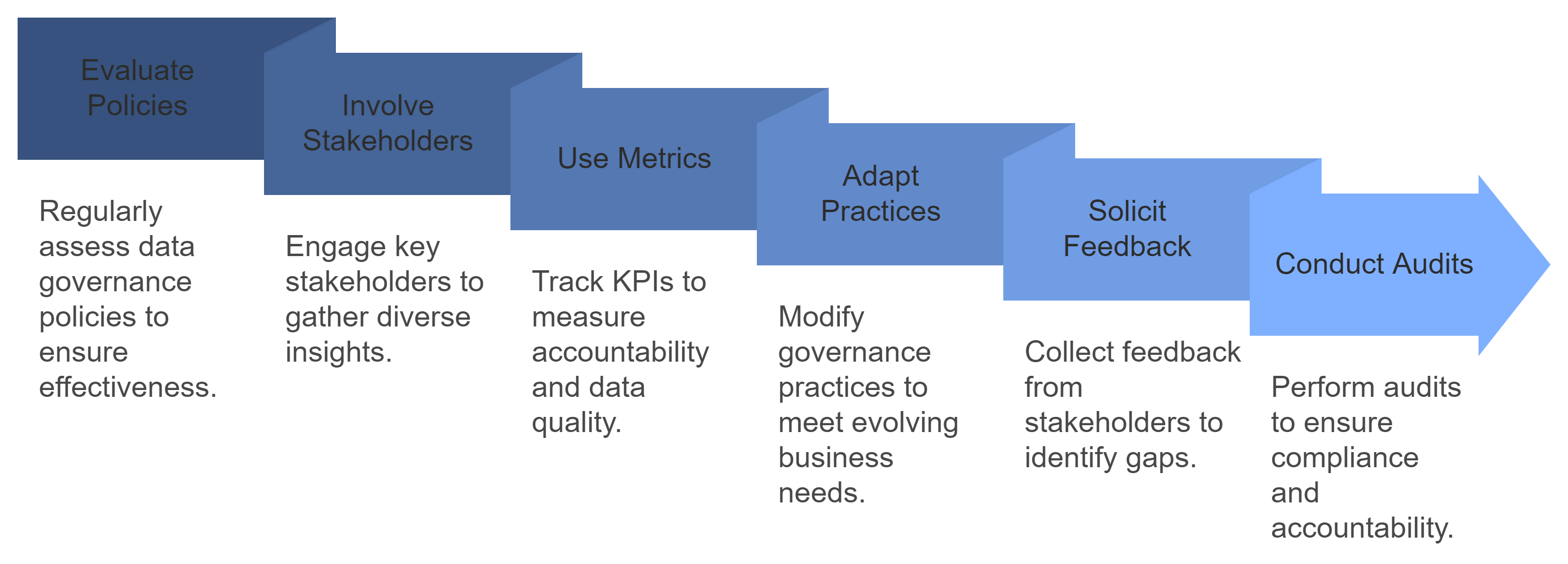
Regularly Evaluate Data Governance Policies
To maintain a robust data governance framework, you must regularly evaluate your policies. This ensures that your governance practices remain effective and relevant. Begin by scheduling periodic reviews of your data governance policies. These reviews help you identify outdated procedures and areas for improvement. For example, as new technologies emerge, your policies may need updates to address potential risks or opportunities.
Involve key stakeholders in these evaluations. Their insights provide a comprehensive understanding of how policies impact different departments. Use feedback from employees to uncover challenges they face in adhering to governance standards. This collaborative approach strengthens your policies and fosters a sense of shared responsibility.
"Accountability is the willingness to accept responsibility for one’s actions and decisions and to be held accountable for the results." – Roger Connors, Tom Smith, and Craig Hickman
By regularly evaluating your policies, you demonstrate a commitment to continuous improvement. This proactive approach ensures that your organization adapts to changes while maintaining a culture of accountability.
Use Metrics to Measure Accountability and Data Quality
Metrics play a crucial role in assessing the success of your data governance efforts. They provide tangible evidence of progress and highlight areas needing attention. Start by identifying key performance indicators (KPIs) that align with your governance goals. Examples include data accuracy rates, compliance audit results, and the number of resolved data quality issues.
Track these metrics consistently using tools like dashboards or automated reporting systems. Dashboards offer a visual representation of your progress, making it easier to communicate results across teams. For instance, a dashboard showing improved data accuracy rates reinforces the importance of accountability in maintaining high-quality data.
Recognize and reward teams or individuals who achieve their targets. Acknowledging their efforts motivates others to take ownership of their responsibilities. As one expert noted, leadership accountability fosters trust and mutual respect within an organization. When employees see their contributions recognized, they feel more engaged and committed to upholding governance standards.
"Leadership accountability helps recognize and reward accountability of your teammates—whether through formal recognition programs or just a simple appreciation."
Using metrics not only measures success but also drives continuous improvement. Regularly analyze your data to identify trends and adjust your strategies accordingly. This iterative process ensures that your organization remains agile and focused on achieving its governance objectives.
Adapt Governance Practices to Evolving Business Needs
Business environments change rapidly, and your governance practices must evolve to keep pace. Adapting to new challenges and opportunities ensures that your organization stays competitive and compliant. Begin by monitoring industry trends and regulatory updates. Staying informed allows you to anticipate changes and adjust your governance framework proactively.
Engage with stakeholders to understand how evolving business needs impact data management. For example, a shift toward remote work may require updates to your data security policies. Collaborate with teams to develop solutions that address these changes while maintaining accountability.
Flexibility is key when adapting governance practices. Avoid rigid policies that hinder innovation or growth. Instead, focus on creating a framework that balances structure with adaptability. This approach empowers your organization to respond effectively to new demands without compromising data integrity.
"Now, let’s turn the page to a chapter often left unspoken: the Accountability Paradox. On one hand, the importance of accountability in leadership is as clear as day—it’s the bedrock of high-performing teams and the cornerstone of effective leadership."
By aligning your governance practices with evolving business needs, you reinforce a culture of accountability. This alignment ensures that your organization remains resilient and prepared for future challenges.
Solicit Feedback from Stakeholders to Identify Gaps
Engaging stakeholders in your data governance process is essential for identifying gaps and improving accountability. Stakeholders, including employees, customers, and partners, offer unique perspectives that can uncover blind spots in your governance framework. Their feedback ensures your policies remain practical and aligned with real-world needs.
Start by creating open channels for communication. Use surveys, interviews, or focus groups to gather input from stakeholders. Ask specific questions about their experiences with data processes, such as accessibility, accuracy, and security. For example, you might ask employees if they face challenges in adhering to governance policies or if they have suggestions for improvement.
"Accountability is the willingness to accept responsibility for one’s actions and decisions and to be held accountable for the results." – Roger Connors, Tom Smith, and Craig Hickman
Encourage honest and constructive feedback by fostering a culture of trust. Assure stakeholders that their input will be valued and used to enhance governance practices. Transparency in how you handle their feedback builds confidence and encourages ongoing participation.
Once you collect feedback, analyze it to identify recurring themes or issues. Prioritize addressing these gaps based on their impact on accountability and data quality. For instance, if multiple stakeholders highlight a lack of clarity in data ownership roles, consider revising your governance framework to define responsibilities more clearly.
Share the outcomes of your feedback analysis with stakeholders. Communicate the changes you plan to implement and explain how their input influenced these decisions. This approach not only reinforces accountability but also strengthens relationships with stakeholders by showing that their voices matter.
Conduct Regular Audits to Ensure Compliance
Regular audits are a cornerstone of maintaining accountability in data governance. Audits provide a systematic way to evaluate your compliance with policies, regulations, and ethical standards. They help you identify weaknesses, mitigate risks, and ensure that everyone adheres to established guidelines.
Begin by scheduling audits at consistent intervals. Quarterly or biannual audits work well for most organizations. During each audit, review key aspects of your governance framework, such as data quality, security measures, and role adherence. For example, check if data stewards are fulfilling their responsibilities or if access controls are effectively protecting sensitive information.
"Organizations that regularly monitor and audit their data activities experience fewer compliance issues and build stronger stakeholder confidence."
Use automated tools to streamline the auditing process. Tools that track data usage, access logs, and compliance metrics provide detailed insights into your governance practices. These tools reduce manual effort and ensure accuracy in your evaluations. For instance, automated alerts can notify you of potential policy violations, allowing you to address issues promptly.
After completing an audit, document your findings in a clear and actionable report. Highlight areas of non-compliance and recommend specific steps for improvement. Share this report with relevant teams and assign accountability for implementing the changes. For example, if an audit reveals gaps in data security, task your IT team with enhancing encryption protocols or updating access controls.
Follow up on audit recommendations to ensure they are implemented effectively. Schedule a review to assess the impact of these changes and determine if further adjustments are needed. This iterative process reinforces a culture of accountability by demonstrating your commitment to continuous improvement.
By soliciting feedback and conducting regular audits, you create a robust system for identifying and addressing gaps in your data governance framework. These practices ensure that your organization remains compliant, trustworthy, and aligned with its accountability goals.
Overcoming Challenges in Building a Culture of Accountability
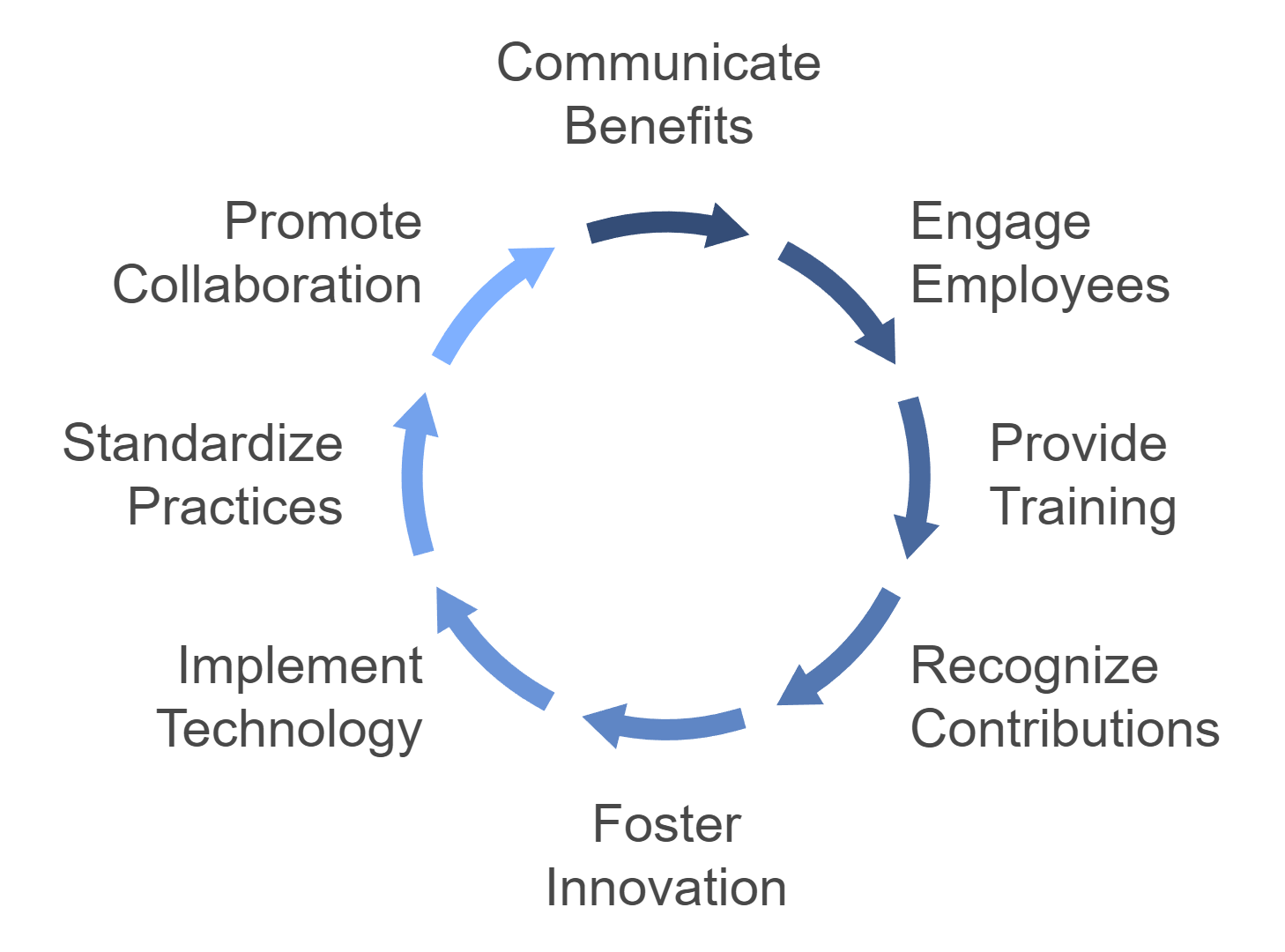
Addressing Resistance to Change
Resistance to change often emerges as one of the biggest obstacles when building a culture of accountability. Employees may feel uncertain about new processes or fear additional scrutiny. To overcome this, you need to focus on creating an environment where change feels less intimidating and more empowering.
Start by communicating the benefits of accountability clearly. Explain how it improves decision-making, enhances trust, and reduces risks. Use real-world examples to show how organizations have successfully implemented accountability practices. For instance, highlight how data catalog tools simplify data management by providing a centralized repository for datasets. These tools make it easier for employees to locate and understand data, reducing confusion and fostering confidence in new systems.
Engage employees early in the process. Involve them in discussions about governance policies and seek their input. When employees feel heard, they are more likely to embrace change. Offer training sessions to help them understand new tools and processes. For example, demonstrate how data lineage tracking tools provide transparency by mapping data flows, making it easier to identify and resolve issues.
Recognize and reward employees who adapt quickly and contribute positively to the transition. Public acknowledgment of their efforts reinforces the value of accountability and motivates others to follow suit. By addressing resistance with clear communication, involvement, and support, you can ease the transition and build a stronger culture of accountability.
Balancing Accountability with Innovation
Accountability and innovation may seem at odds, but they can coexist when approached thoughtfully. While accountability ensures adherence to governance policies, innovation drives growth and creativity. Striking the right balance requires you to create a framework that supports both.
Encourage innovation by providing employees with the tools they need to experiment responsibly. For instance, automated data governance solutions streamline repetitive tasks, freeing up time for employees to focus on creative problem-solving. Automation also reduces errors, ensuring that innovative ideas align with governance standards.
Foster a culture where employees feel safe to take calculated risks. Emphasize that accountability does not mean punishing mistakes but learning from them. Use monitoring tools to track data usage and identify areas for improvement. For example, data governance dashboards provide insights into compliance and data quality, helping teams refine their processes without stifling creativity.
Set clear boundaries for innovation. Define which data practices are non-negotiable, such as adhering to privacy regulations or maintaining data accuracy. Within these boundaries, give employees the freedom to explore new ideas. This approach ensures that innovation thrives while accountability remains intact.
"Balancing accountability with innovation requires a structured yet flexible framework that empowers employees to think creatively while upholding governance standards."
By integrating accountability into your innovation strategy, you create an environment where creativity and responsibility go hand in hand.
Ensuring Scalability of Governance Practices
As your organization grows, your governance practices must scale to meet increasing demands. Without scalability, maintaining accountability becomes challenging. To ensure your governance framework evolves with your organization, you need to adopt strategies that support growth.
Leverage technology to automate governance tasks. Automated data governance solutions handle processes like data quality checks, metadata management, and compliance monitoring. Automation reduces manual effort, making it easier to manage larger volumes of data without compromising accountability.
Implement tools that adapt to your organization's needs. For example, data catalog solutions offer features like metadata management and data discovery, which simplify data organization as your datasets expand. These tools enhance accessibility and transparency, ensuring that employees can locate and use data efficiently, even in a growing environment.
Standardize your governance policies to ensure consistency across departments. Use templates and guidelines to document roles, responsibilities, and processes. Regularly review and update these documents to reflect changes in your organization. Standardization ensures that everyone follows the same principles, regardless of scale.
Train employees to adapt to scalable governance practices. Offer workshops on using tools like data lineage tracking to maintain transparency as data flows increase. Encourage cross-departmental collaboration to ensure that governance practices remain cohesive.
By focusing on scalability, you future-proof your governance framework. This approach ensures that accountability remains a core value, even as your organization evolves.
Overcoming Silos in Data Management
Silos in data management create barriers that hinder collaboration, transparency, and efficiency. When departments or teams manage data independently, inconsistencies and redundancies often arise. Breaking down these silos is essential to fostering a culture of accountability and ensuring seamless data governance.
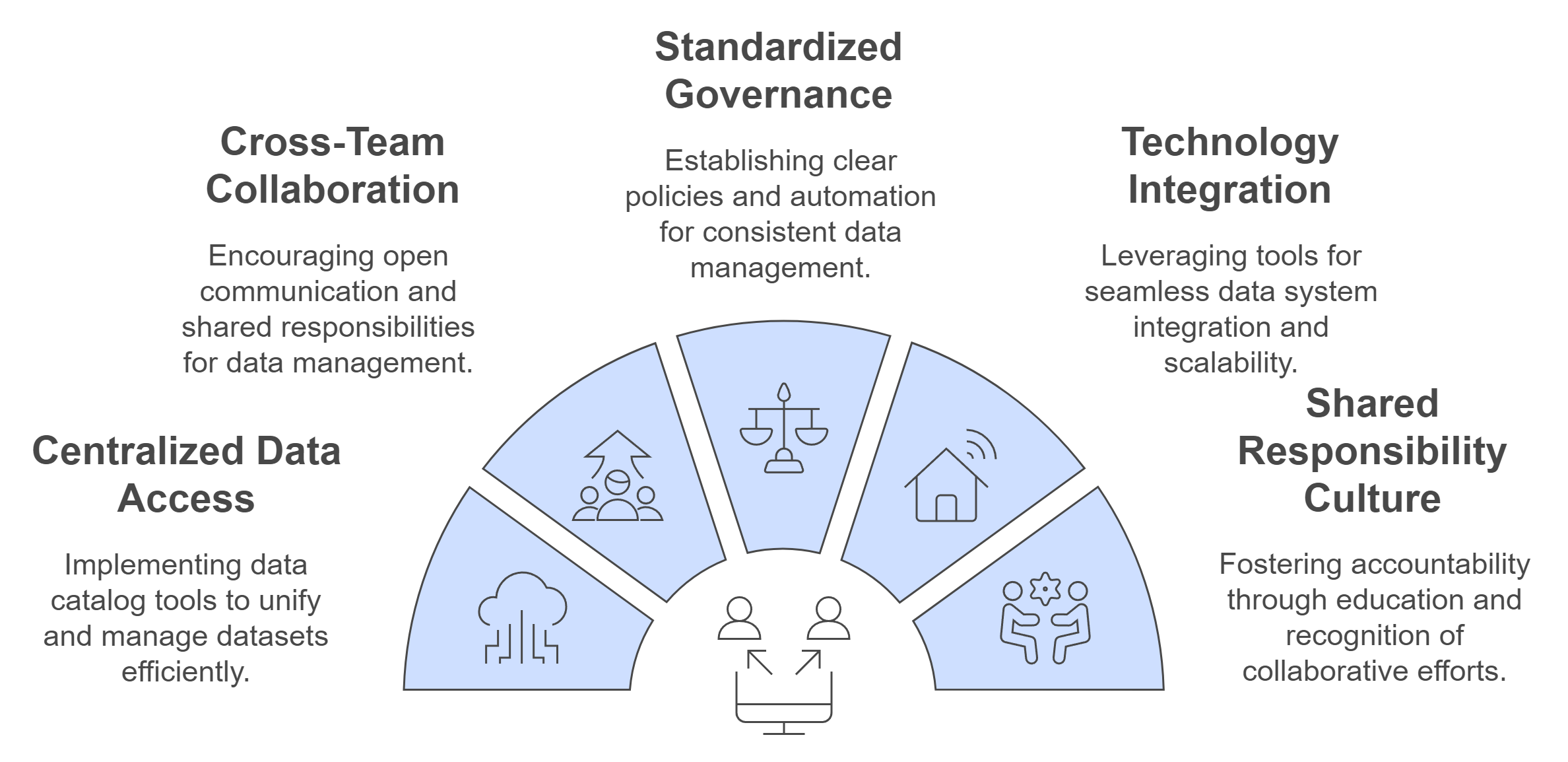
1. Promote Centralized Data Access
Centralizing data access eliminates the fragmentation caused by isolated data systems. Implementing data catalog tools provides a unified platform where all datasets are stored and managed. These tools enhance accessibility by offering features like metadata management and data discovery. For example, a centralized data catalog allows employees to locate and understand datasets without relying on multiple systems. This approach reduces confusion and ensures everyone works with the same accurate and consistent data.
"Data catalog solutions simplify data organization, making it easier for teams to collaborate and maintain accountability."
Encourage all departments to contribute to the central repository. Regularly update the catalog to reflect new datasets or changes in existing ones. This practice ensures that your data remains relevant and reliable.
2. Foster Cross-Team Collaboration
Collaboration between teams is vital to overcoming silos. Encourage open communication and shared responsibilities for data management. Use tools like data lineage tracking to provide transparency into how data flows across departments. These tools visually map data journeys, helping teams understand dependencies and identify potential bottlenecks.
Organize regular cross-departmental meetings to discuss data challenges and align on governance practices. During these sessions, share insights and best practices to ensure consistency. Collaborative platforms, such as shared dashboards, further enhance teamwork by providing a clear view of data-related tasks and progress.
3. Standardize Data Governance Practices
Standardization ensures that all teams follow the same rules and procedures for managing data. Develop clear policies outlining roles, responsibilities, and processes. Document these policies in a centralized location, such as your data governance framework, so everyone can access and understand them.
Use automation to enforce standardization. Automated data governance tools streamline repetitive tasks like data validation and compliance monitoring. Automation reduces human error and ensures that all teams adhere to the same standards. For instance, automated alerts can notify you of policy violations, allowing you to address issues promptly.
4. Leverage Technology for Integration
Integrating data systems bridges gaps between siloed departments. Tools like data catalogs and metadata management enable seamless integration by providing detailed information about datasets. These tools make it simple to search, reuse, and share data across teams. For example, metadata management ensures that everyone understands the context and purpose of the data they use.
Adopt scalable solutions that grow with your organization. Scalable tools, such as automated data governance platforms, adapt to increasing data volumes and complexities. This flexibility ensures that your governance practices remain effective as your organization evolves.
5. Encourage a Culture of Shared Responsibility
Accountability thrives when employees view data stewardship as a shared responsibility. Educate teams on the importance of collaboration and transparency in data management. Offer training programs to improve data literacy and familiarize employees with governance tools. For instance, workshops on using data lineage tools can help teams understand their role in maintaining data integrity.
Recognize and reward collaborative efforts. Highlight success stories where teams worked together to overcome data challenges. Public acknowledgment reinforces the value of shared responsibility and motivates others to follow suit.
By addressing silos in data management, you create an environment where collaboration and accountability flourish. Centralized access, standardized practices, and integrated tools ensure that your organization manages data effectively and responsibly.
The Role of Leadership in Driving a Culture of Accountability
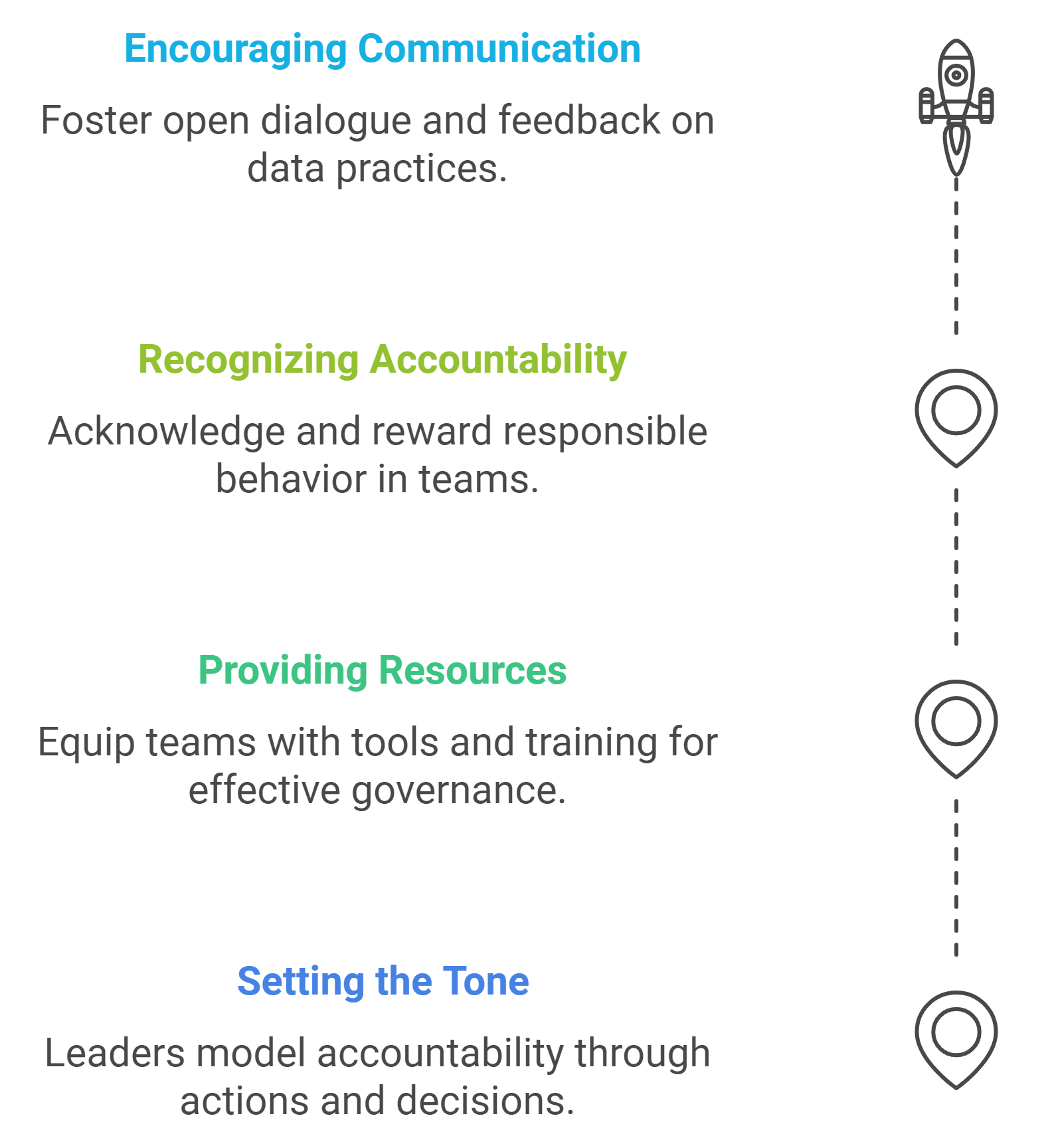
Setting the Tone from the Top
Leadership sets the foundation for a culture of accountability. As a leader, your actions and decisions influence how employees perceive and adopt accountability practices. When you model responsible data management, you demonstrate its importance to the entire organization. For example, adhering to data governance policies and ensuring compliance with regulations shows your commitment to ethical practices.
Transparency is a key element in setting the tone. Share your data-driven decisions and explain the steps you took to ensure accuracy and integrity. This openness builds trust and encourages employees to follow your example. Use tools like automated dashboards to visualize key metrics and share progress with your team. These dashboards provide real-time insights into data quality and governance efforts, reinforcing the importance of accountability.
Regular communication also plays a vital role. Host meetings to discuss governance goals and challenges. Use these opportunities to emphasize the value of accountability in achieving organizational success. By consistently demonstrating and communicating your commitment, you inspire others to take ownership of their responsibilities.
"Leadership is not about being in charge. It is about taking care of those in your charge." – Simon Sinek
Providing Resources and Support for Governance Initiatives
To foster accountability, you must equip your team with the right tools and resources. Investing in technologies like data governance tools simplifies complex processes and reduces manual effort. For instance, tools that automate data quality checks and track data lineage ensure consistency and accuracy, freeing up your team to focus on strategic tasks.
Training programs are equally important. Educate employees on data governance principles and their roles in maintaining accountability. Offer workshops or online courses to improve data literacy and familiarize your team with tools like data catalog solutions. These tools enhance data accessibility and usability, enabling employees to make informed decisions.
Provide ongoing support by addressing challenges promptly. Use project management software to track progress and identify bottlenecks. These tools help you monitor tasks and ensure that everyone stays aligned with governance objectives. Recognize that accountability thrives when employees feel supported and empowered to succeed.
Recognizing and Rewarding Accountability in Teams
Recognition reinforces positive behavior and motivates employees to uphold accountability. Acknowledge individuals or teams who demonstrate exceptional responsibility in data management. Publicly celebrating their efforts highlights the importance of accountability and inspires others to follow suit.
Use metrics to measure and reward accountability. For example, track improvements in data quality or compliance rates using BI tools. Share these achievements through interactive dashboards, making progress visible to the entire organization. This transparency fosters a sense of pride and encourages continuous improvement.
Incorporate rewards into your governance strategy. Offer incentives like bonuses, promotions, or professional development opportunities for employees who excel in their roles. Even simple gestures, such as verbal praise or written acknowledgments, can have a significant impact. By recognizing and rewarding accountability, you create a culture where responsibility becomes second nature.
"What gets rewarded gets repeated." – John E. Jones
Encouraging Open Communication About Data Practices
Open communication about data practices strengthens accountability and fosters trust within your organization. When employees feel informed and empowered, they are more likely to take ownership of their roles in data governance. To encourage this culture, you need to establish clear channels for dialogue, provide accessible tools, and promote transparency.
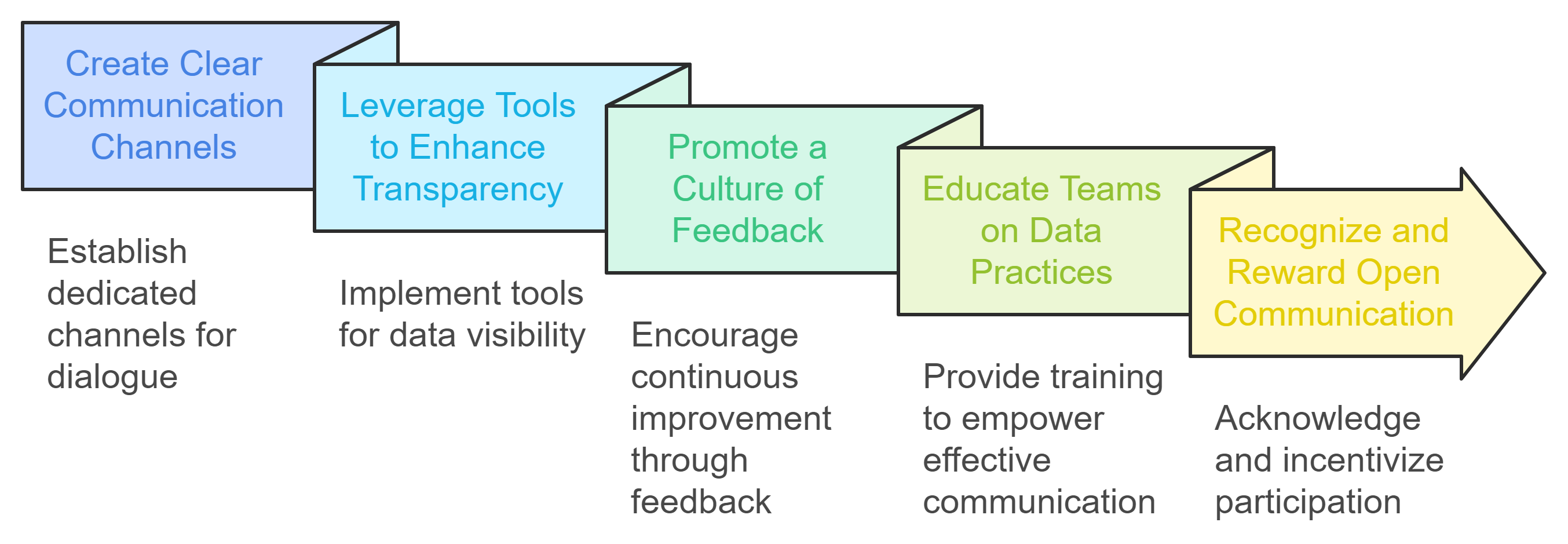
1. Create Clear Communication Channels
Establishing dedicated communication channels ensures that employees can easily share concerns, ask questions, or provide feedback about data practices. Use platforms like project management software or team collaboration tools to facilitate these discussions. For example, create a shared space where teams can document challenges or propose improvements to governance processes. This approach encourages active participation and helps identify gaps in your data management framework.
Regular meetings also play a vital role. Schedule sessions where teams can discuss data-related issues and align on governance goals. Use these opportunities to address common concerns and reinforce the importance of accountability. By fostering open dialogue, you create an environment where employees feel heard and valued.
2. Leverage Tools to Enhance Transparency
Transparency in data practices builds confidence and ensures that everyone understands their responsibilities. Implement tools like data catalog solutions to provide a centralized view of your organization's data assets. These tools make it easy for employees to locate and understand datasets, reducing confusion and promoting responsible usage.
Automated dashboards further enhance transparency by consolidating key metrics in real time. These dashboards display insights into data quality, usage patterns, and compliance efforts. For instance, a dashboard might show the percentage of validated data or highlight areas requiring attention. Sharing these visualizations during team meetings keeps everyone informed and aligned with governance objectives.
"When employees have access to clear and organized data insights, they are more likely to engage in responsible and informed decision-making."
3. Promote a Culture of Feedback
Encouraging feedback ensures continuous improvement in your data governance practices. Create opportunities for employees to share their experiences with data processes. Use surveys or focus groups to gather input on challenges they face or suggestions for improvement. For example, ask employees if they find tools like data lineage tracking helpful in understanding data flows or if additional training is needed.
Act on the feedback you receive. Communicate the changes you plan to implement and explain how employee input influenced these decisions. This transparency reinforces trust and motivates employees to contribute actively to governance initiatives.
4. Educate Teams on Data Practices
Education empowers employees to communicate effectively about data practices. Offer training programs that improve data literacy and familiarize teams with governance tools. For instance, workshops on using data management software can help employees understand how to enforce policies and track data lineage. Interactive sessions also provide a platform for employees to ask questions and clarify doubts.
Integrate education into onboarding processes to instill accountability from the start. New hires should understand their roles in maintaining data quality, security, and compliance. By prioritizing education, you equip your workforce with the knowledge needed to engage in meaningful conversations about data governance.
5. Recognize and Reward Open Communication
Acknowledging employees who actively participate in discussions about data practices reinforces the value of open communication. Highlight examples where feedback led to improvements in governance processes. Public recognition motivates others to share their insights and fosters a collaborative environment.
Incentives can also encourage participation. Offer rewards for innovative ideas that enhance data governance or for identifying potential risks. Even simple gestures, like verbal praise during meetings, can have a significant impact. By celebrating open communication, you create a culture where accountability thrives.
Encouraging open communication about data practices requires consistent effort and the right tools. By establishing clear channels, leveraging technology, and promoting transparency, you empower your team to take ownership of their roles in data governance. This approach not only strengthens accountability but also drives continuous improvement across your organization.
Case Studies: Organizations That Built a Culture of Accountability Through Data Governance
Example 1: How Company A Improved Data Quality and Trust Through Governance
Company A, a global retail organization, faced challenges with inconsistent data quality across its departments. These inconsistencies led to errors in reporting and reduced trust in the data used for decision-making. To address this, the company implemented a structured data governance framework focused on improving data quality and fostering accountability.
The first step involved assigning clear ownership of data assets. Each department designated data stewards responsible for maintaining the accuracy and consistency of their datasets. Regular data validation processes were introduced to identify and correct errors. The company also adopted a data catalog tool, which provided a centralized repository for all data assets. This tool enhanced visibility and allowed employees to access reliable data without confusion.
Training programs played a crucial role in this transformation. Employees across departments completed annual data governance training, achieving a 100% completion rate. These programs improved data literacy and ensured that everyone understood their roles in maintaining data quality. Metrics showed a significant reduction in data-related errors, and trust in the organization’s data increased.
"By prioritizing data quality and accountability, Company A optimized operations and improved decision-making with reliable data."
Example 2: How Company B Enhanced Compliance and Transparency with Clear Policies
Company B, a financial services provider, struggled to meet regulatory requirements due to fragmented data management practices. Compliance audits revealed gaps in data security and privacy measures, putting the organization at risk of penalties. To overcome these challenges, Company B developed clear governance policies and integrated them into its operations.
The organization began by defining roles and responsibilities for data governance. Specific teams were tasked with monitoring compliance and ensuring adherence to ethical standards. Automated tools, such as data lineage tracking systems, were implemented to trace the flow of data and ensure transparency. These tools provided detailed records of how data was collected, processed, and shared, making it easier to demonstrate compliance during audits.
Regular audits became a cornerstone of their strategy. These audits identified potential risks and ensured that governance policies remained effective. The company also introduced monitoring systems to track data activities in real time, reducing the likelihood of unauthorized access or breaches. As a result, compliance audits became more efficient, and the organization experienced fewer regulatory issues.
"Clear policies and advanced tools enabled Company B to enhance transparency and build trust with stakeholders, ensuring long-term success."
Lessons Learned from Real-World Examples
These case studies highlight valuable lessons for building a culture of accountability through data governance:
Assign Clear Ownership
Designating data stewards and owners ensures accountability for data quality and compliance. This approach reduces errors and fosters trust in organizational data.Leverage Technology
Tools like data catalogs and lineage tracking systems enhance visibility and transparency. They simplify data management and ensure adherence to governance policies.Invest in Training
Comprehensive training programs improve data literacy and empower employees to take responsibility for their roles. High training completion rates lead to better governance outcomes.Conduct Regular Audits
Periodic audits identify gaps and ensure compliance with regulations. They also provide opportunities to refine governance practices and reduce risks.Focus on Transparency
Transparent data practices build trust among stakeholders and improve decision-making. Clear documentation and accessible tools make it easier for employees to follow governance standards.
"Organizations that prioritize accountability and adopt structured governance frameworks experience improved data quality, operational efficiency, and stakeholder trust."
By learning from these examples, you can implement strategies that align with your organization’s goals and foster a culture of accountability.
Integrating accountability into data governance practices is essential for fostering trust, compliance, and operational efficiency. By defining clear roles, promoting collaboration, and leveraging tools like data catalogs and lineage tracking systems, you can create a robust framework that supports a culture of accountability. Regular training and stakeholder engagement further strengthen this foundation, ensuring continuous improvement.
Take actionable steps today. Evaluate your current data governance practices, identify gaps, and implement strategies to address them. Building a culture of accountability empowers your organization to make informed decisions and achieve long-term success.
See Also
Understanding Data Governance: Key Principles And Practices
A Comprehensive Approach To Developing Data Governance Strategies
How Data Governance Contributes To Maintaining Data Quality
The Importance Of Data Stewards For Governance Effectiveness
